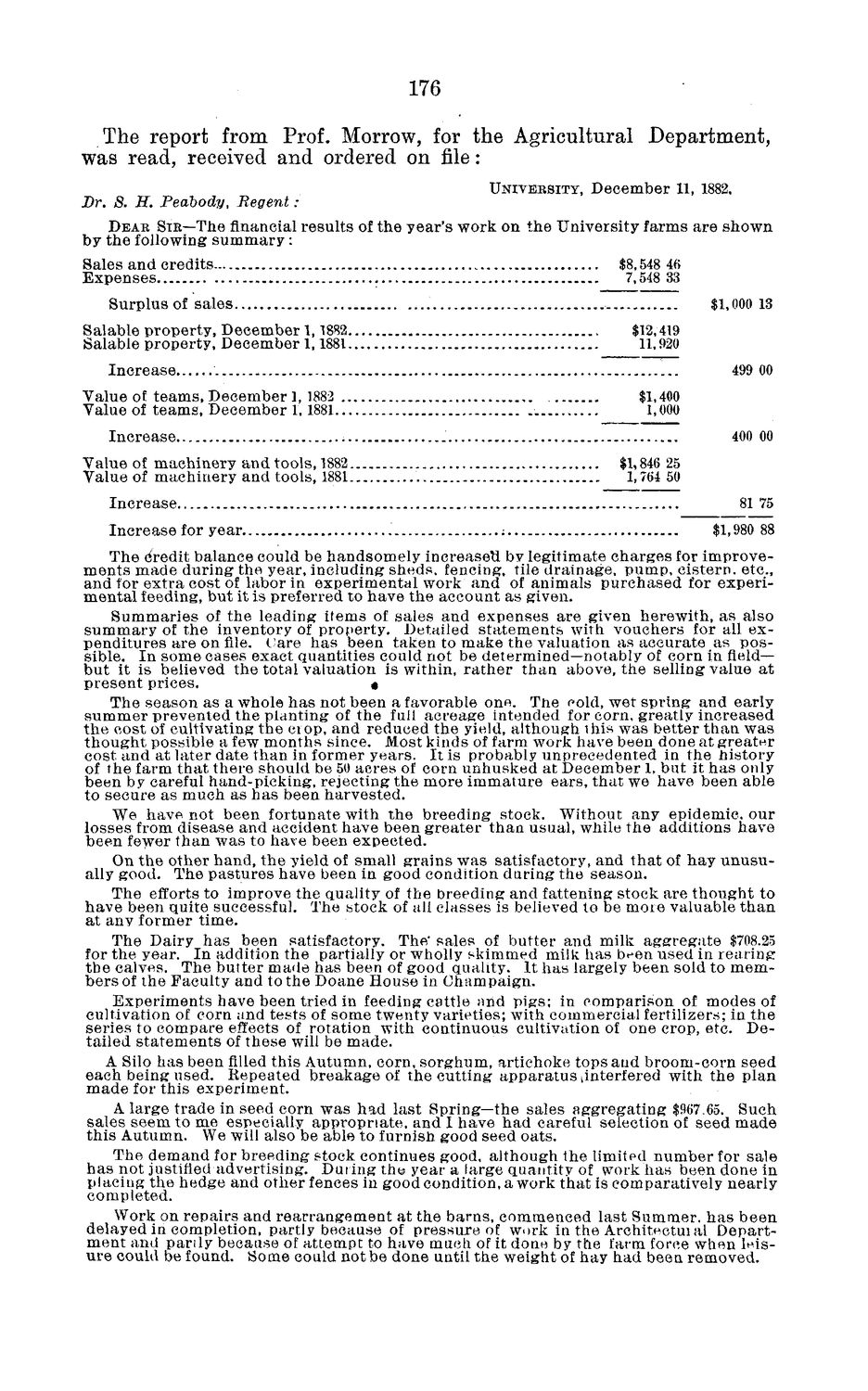| |
| |
Caption: Board of Trustees Minutes - 1884
This is a reduced-resolution page image for fast online browsing.

EXTRACTED TEXT FROM PAGE:
176 The report from Prof. Morrow, for the Agricultural Department, was read, received and ordered on file: Dr. 8. H. Peabody, Regent : DEAR SIR—The financial results of the year's work on the University farms are shown by the following summary: Sales and credits $8,548 46 Expenses . 7,548 33 Surplus of sales $1,000 13 Salable property, December 1,1882 $12,419 Salable property, December 1,1881 11,920 Increase 499 00 Value of teams, December], 1882 ,. $1,400 Value of teams, December 1,1881 1,000 Increase 400 00 Value of machinery and tools, 1882 $1,846 25 Value of machinery and tools, 1881 Increase 1,764 50 81 75 UNIVERSITY, December 11, 1882. Increase for year ; $1,980 88 The Credit balance could be handsomely increased by legitimate charges for improvements made during the year, including sheds, fencing, tile drainage, pump, cistern, etc., and for extra cost of labor in experimental work and of animals purchased for experimental feeding, but it is preferred to have the account as given. Summaries of the leading items of sales and expenses are given herewith, as also summary of the inventory of property. Detailed statements with vouchers for all expenditures are on file. Care has been taken to make the valuation as accurate as possible. In some cases exact quantities could not be determined—notably of corn in fieldbut it is believed the total valuation is within, rather than above, the selling value at present prices. « The season as a whole has not been a favorable one. The cold, wet spring and early summer prevented the planting of the full acreage intended for corn, greatly increased the cost of cultivating the crop, and reduced the yield, although this was better than was thought possible a few months since. Most kinds of farm work have been done at greater cost and at later date than in former years. It is probably unprecedented in the history of the farm that there should be 50 acres of corn unhusked at December 1, but it has only been by careful hand-picking, rejecting the more immature ears, that we have been able to secure as much as has been harvested. We have not been fortunate with the breeding stock. Without any epidemic, our losses from disease and accident have been greater than usual, while the additions have been fewer than was to ha\ e been expected. On the other hand, the yield of small grains was satisfactory, and that of hay unusually good. The pastures have been in good condition during the season. The efforts to improve the quality of the breeding and fattening stock are thought to have been quite successful. The stock of all classes is believed to be more valuable than at any former time. The Dairy has been satisfactory. The' sales of butter and milk aggregate $708.25 for the year. In addition the partially or wholly skimmed milk has been used in rearing the calves. The butter made has been of good quality. It has largely been sold to members of the Faculty and to the Doane House in Champaign. Experiments have been tried in feeding cattle and pigs; in comparison of modes of cultivation of corn and tests of some twenty varieties; with commercial fertilizers; in the series to compare effects of rotation with continuous cultivation of one crop, etc. Detailed statements of these will be made. A Silo has been filled this Autumn, corn, sorghum, artichoke tops and broom-corn seed each being used. Repeated breakage of the cutting apparatus interfered with the plan made for this experiment. A large trade in seed corn was had last Spring—the sales aggregating $967.65. Such sales seem to me especially appropriate, and I have had careful selection of seed made this Autumn. We will also be able to furnish good seed oats. The demand for breeding stock continues good, although the limited number for sale has not justified advertising. During the year a large quantity of work has been done in placing the hedge and other fences in good condition, a work that is comparatively nearly completed. Work on repairs and rearrangement at the barns, commenced last Summer, has been delayed in completion, partly because of pressure of work in the Archit^ctuial Department and parily because of attempt to have much of it done by the farm force when leisure could be found. Some could not be done until the weight of hay had been removed.
| |